Global Passwordless Authentication Market: By Offering, By Authentication Type, By Mobility, By Technology, By End-Use Industry, By Region & Segmental Insights Trends and Forecast, 2024 – 2034
- Industry: Technology
- Report ID: TNR-110-1096
- Number of Pages: 420
- Table/Charts : Yes
- May, 2024
- Base Year : 2024
- No. of Companies : 10+
- No. of Countries : 29
- Views : 10241
- Covid Impact Covered: Yes
- War Impact Covered: Yes
- Formats : PDF, Excel, PPT
Passwordless authentication is an approach to user authentication that eliminates the need for traditional passwords, replacing them with alternative methods of verifying a user’s identity. This authentication method aims to enhance security, user experience, and convenience by leveraging various authentication factors other than passwords.
Biometric authentication utilizes unique physical characteristics of individuals, such as fingerprints, facial features, iris patterns, or voiceprints, to verify their identity. Biometric data is captured and compared against stored templates to grant access without the need for passwords. Benefits of passwordless authentication include enhanced security, as passwords are susceptible to various security risks such as phishing, credential stuffing, and password reuse. Passwordless methods also improve user experience by reducing friction during the authentication process, eliminating the need to remember complex passwords, and offering more convenient and intuitive authentication options. Additionally, passwordless authentication aligns with modern security best practices and regulatory requirements, making it an attractive option for organizations seeking to enhance security and usability in their authentication workflows.
In terms of revenue, the global passwordless authentication market was worth US$ 13.2 Bn in 2023, anticipated to witness CAGR of 12.8% During 2024 – 2034.
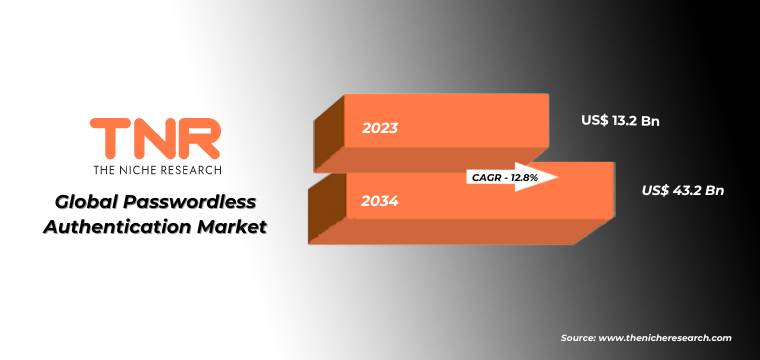
Trends in the Global Passwordless Authentication Market
- Rise of Biometric Authentication: Biometric authentication methods, such as fingerprint recognition, facial recognition, iris scanning, and voice recognition, are increasingly being adopted as passwordless authentication solutions. The proliferation of biometric sensors in smartphones and other devices, along with advancements in biometric algorithms and security, is driving the growth of biometric authentication in various industries.
- Expansion of FIDO Standards: The adoption of FIDO (Fast Identity Online) standards, including FIDO2 and WebAuthn, is gaining momentum across the industry. These standards provide a framework for passwordless authentication using public key cryptography and enable interoperability between different authentication methods and devices. Organizations are leveraging FIDO-compliant solutions to enhance security and user experience in their authentication processes.
- Integration with Identity and Access Management (IAM) Solutions: Passwordless authentication is increasingly being integrated with IAM platforms to provide centralized identity management and authentication capabilities. IAM solutions offer features such as single sign-on (SSO), multi-factor authentication (MFA), and identity governance, which complement passwordless authentication and enhance overall security posture.
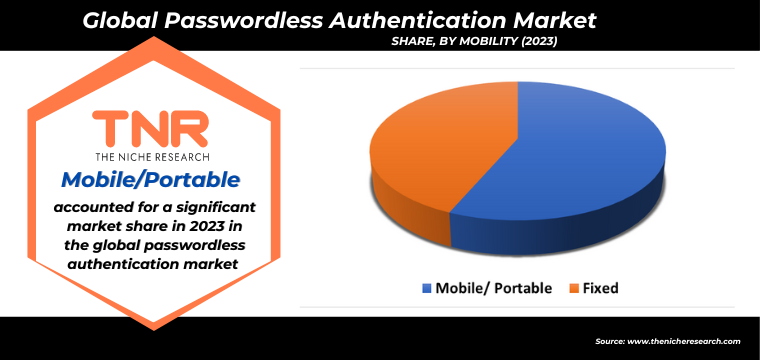
Mobile/Portable segment has garnered major market share in the global passwordless authentication market in 2023.
Passwordless authentication methods, such as biometrics (e.g., fingerprint, facial recognition) and push notifications, offer a seamless and user-friendly authentication experience on mobile devices. Unlike traditional password-based authentication, which can be cumbersome and error-prone, passwordless methods eliminate the need for users to remember complex passwords and input them manually. This improved user experience enhances customer satisfaction and encourages adoption of mobile passwordless authentication solutions.
Regulatory frameworks such as GDPR, PSD2, and CCPA mandate strong authentication measures to protect user data and privacy, especially in mobile applications that handle sensitive information. Passwordless authentication methods help organizations comply with regulatory requirements by reducing reliance on passwords, which are often targeted in cyberattacks. Mobile passwordless authentication solutions that meet regulatory standards for security and privacy are in high demand among organizations.
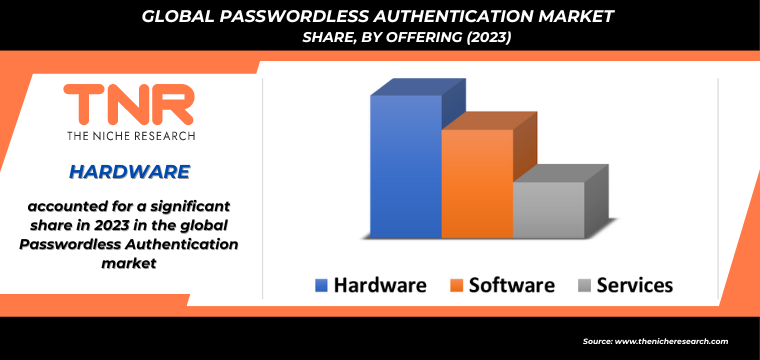
Hardware segment had the highest share in the global Passwordless Authentication Market in 2023.
Hardware-based authentication solutions, such as security keys and smart cards, offer a higher level of security compared to traditional password-based methods. These hardware devices store cryptographic keys or biometric data locally, reducing the risk of credential theft, phishing attacks, and unauthorized access. As organizations prioritize security in their authentication processes, there is a growing demand for hardware-based solutions that provide robust protection against cyber threats.
Ongoing advancements in hardware technology, such as the miniaturization of security keys, the integration of biometric sensors, and the development of tamper-resistant hardware, drive innovation in the passwordless authentication market. Manufacturers continuously improve the design, performance, and functionality of hardware-based authentication devices to meet the evolving needs of organizations and end-users. These technological advancements enhance the reliability, usability, and security of hardware-based passwordless authentication solutions, driving adoption in diverse industries and use cases.
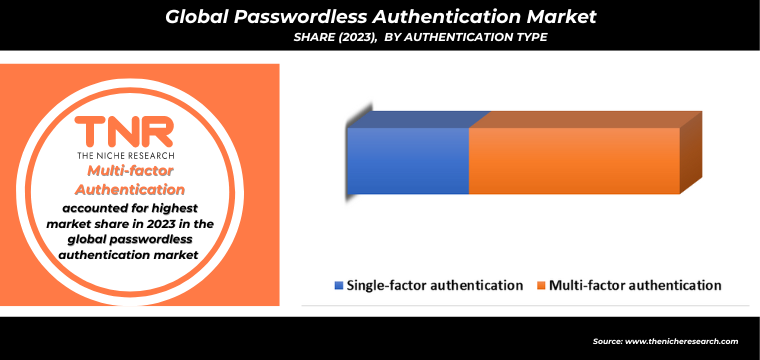
By End Use Industry government industry segment had the highest share in the global Passwordless Authentication Market in 2023.
Government agencies manage sensitive information and critical infrastructure that are prime targets for cyberattacks. Traditional password-based authentication methods are vulnerable to various security threats such as phishing, credential theft, and brute-force attacks. Passwordless authentication solutions, which leverage biometric data, cryptographic keys, or other authentication factors, offer enhanced security and protection against unauthorized access. Government agencies prioritize security and are increasingly adopting passwordless authentication to safeguard sensitive data and critical systems from cyber threats.
Government agencies are subject to strict regulatory frameworks and compliance standards related to data security, privacy, and access control. Regulations such as FISMA (Federal Information Security Management Act), NIST SP 800-63, and GDPR (General Data Protection Regulation) mandate strong authentication measures to protect sensitive information and ensure privacy rights. Passwordless authentication solutions enable government agencies to comply with regulatory requirements by offering multi-factor authentication (MFA) capabilities that enhance security and mitigate the risk of data breaches. Compliance with industry standards and regulations is a key driver for the adoption of passwordless authentication in the government sector.
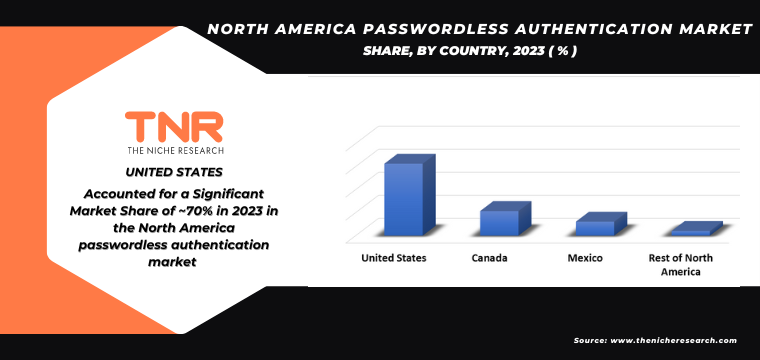
North American organizations must comply with various regulatory frameworks and industry standards related to data security and privacy.
Regulations such as HIPAA (Health Insurance Portability and Accountability Act), PCI DSS (Payment Card Industry Data Security Standard), and NIST SP 800-63 mandate strong authentication measures to protect sensitive information and ensure privacy rights. Passwordless authentication solutions help organizations meet regulatory requirements by offering multi-factor authentication (MFA) capabilities that enhance security and reduce the risk of data breaches.
Compliance with regulatory standards drives the adoption of passwordless authentication across industries in North America. With the increasing frequency and sophistication of cyberattacks, organizations in North America are prioritizing cybersecurity measures to protect sensitive data and mitigate risks. Traditional password-based authentication methods are prone to vulnerabilities such as phishing, credential theft, and brute-force attacks. Passwordless authentication solutions offer a more secure alternative by leveraging biometric data, cryptographic keys, or other authentication factors to verify user identities without relying on passwords. As organizations seek robust cybersecurity solutions, the demand for passwordless authentication is on the rise in North America.
Competitive Landscape: Global Passwordless Authentication Market are
- Beyond Identity
- DUO Security
- Entrust
- Fujitsu
- HID Global
- IBM
- Microsoft
- NEC
- OKTA
- OneLogin
- Thales
- Veridium
- Other Industry Participants
Global Passwordless Authentication Market Scope
| Report Specifications | Details |
| Market Revenue in 2023 | US$ 13.2 Bn |
| Market Size Forecast by 2034 | US$ 43.2 Bn |
| Growth Rate (CAGR) | 12.8% |
| Historic Data | 2016 – 2022 |
| Base Year for Estimation | 2023 |
| Forecast Period | 2024 – 2034 |
| Report Inclusions | Market Size & Estimates, Market Dynamics, Competitive Scenario, Trends, Growth Factors, Market Determinants, Key Investment Segmentation, Product/Service/Solutions Benchmarking |
| Segments Covered | By Offering, By Authentication Type, By Mobility, By Technology, By End-Use Industry |
| Regions Covered | North America, Europe, Asia Pacific, Middle East & Africa, Latin America |
| Countries Covered | U.S., Canada, Mexico, Rest of North America, France, The UK, Spain, Germany, Italy, Nordic Countries (Denmark, Finland, Iceland, Sweden, Norway), Benelux Union (Belgium, The Netherlands, Luxembourg), Rest of Europe, China, Japan, India, New Zealand, Australia, South Korea, Southeast Asia (Indonesia, Thailand, Malaysia, Singapore, Rest of Southeast Asia), Rest of Asia Pacific, Saudi Arabia, UAE, Egypt, Kuwait, South Africa, Rest of Middle East & Africa, Brazil, Argentina, Rest of Latin America |
| Key Players | Beyond Identity, DUO Security, Entrust, Fujitsu, HID Global, IBM, Microsoft, NEC, OKTA, OneLogin, Thales, Veridium, Other Market Participants |
| Customization Scope | Customization allows for the inclusion/modification of content pertaining to geographical regions, countries, and specific market segments. |
| Pricing & Procurement Options | Explore purchase options tailored to your specific research requirements |
| Contact Details | Consult With Our Expert
Japan (Toll-Free): +81 663-386-8111 South Korea (Toll-Free): +82-808- 703-126 Saudi Arabia (Toll-Free): +966 800-850-1643 United Kingdom: +44 753-710-5080 United States: +1 302-232-5106 E-mail: askanexpert@thenicheresearch.com
|
Global Passwordless Authentication Market
By Offering
- Hardware
- Software
- Services
By Authentication Type
- Single-factor authentication
- Multi-factor authentication
By Mobility
- Mobile/ Portable
- Fixed
By Technology
- Fingerprint or Thumbprint Authentication
- Authentication Using Face Recognition
- Challenge Response Authentication Mechanism
- Others
By End Use Industry
- Healthcare
- Banking, financial services and insurance (BFSI)
- IT and Telecom
- Retail and Consumer Electronics
- Government
- Manufacturing
- Transportation and Logistics
- Others
By Region
- North America (U.S., Canada, Mexico, Rest of North America)
- Europe (France, The UK, Spain, Germany, Italy, Nordic Countries (Denmark, Finland, Iceland, Sweden, Norway), Benelux Union (Belgium, The Netherlands, Luxembourg), Rest of Europe)
- Asia Pacific (China, Japan, India, New Zealand, Australia, South Korea, Southeast Asia (Indonesia, Thailand, Malaysia, Singapore, Rest of Southeast Asia), Rest of Asia Pacific)
- Middle East & Africa (Saudi Arabia, UAE, Egypt, Kuwait, South Africa, Rest of Middle East & Africa)
- Latin America (Brazil, Argentina, Rest of Latin America)
Report Representation:
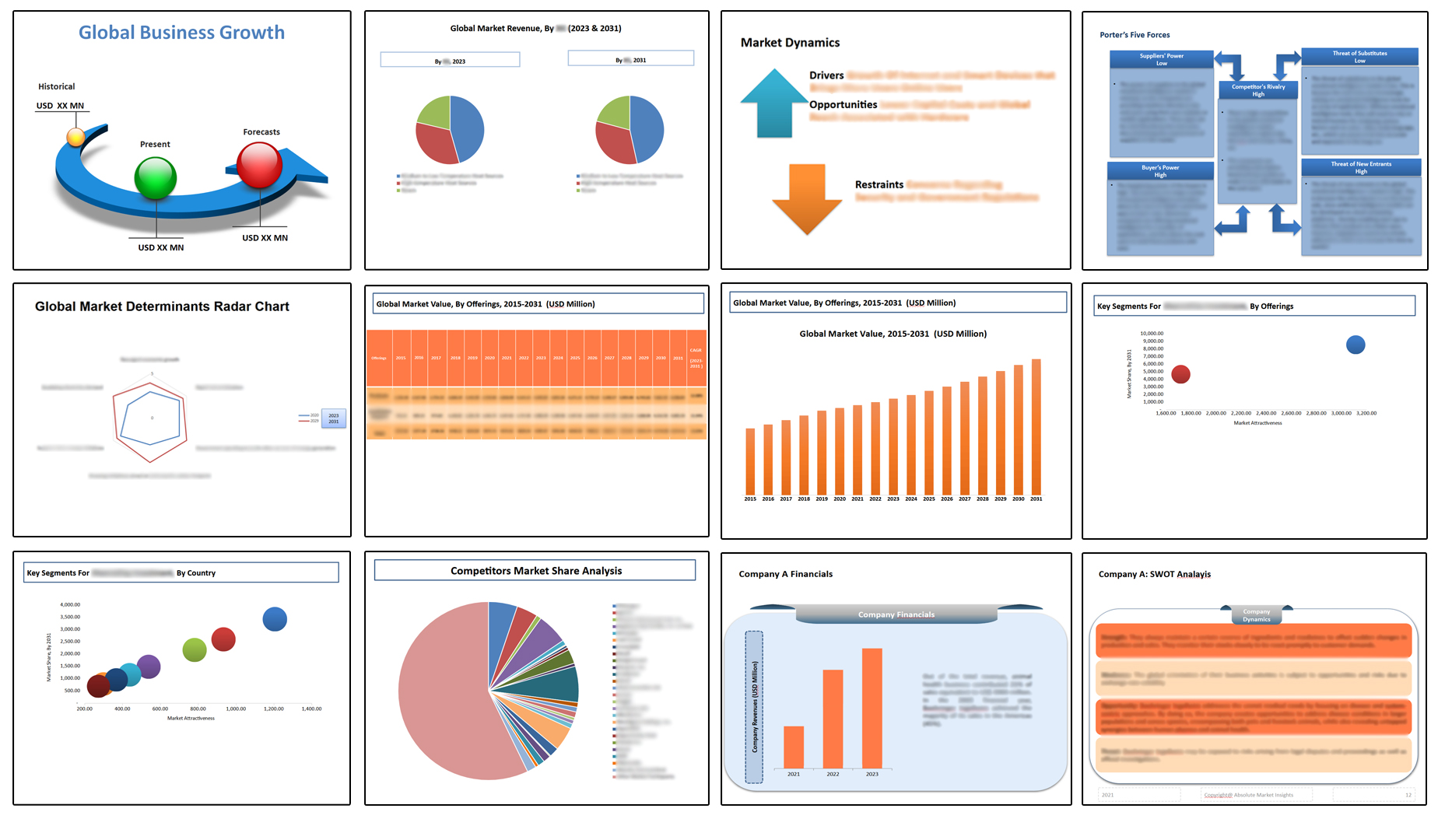
Table of Contents
**Exclusive for Multi-User and Enterprise User.
Global Passwordless Authentication Market
By Offering
- Hardware
- Software
- Services
By Authentication Type
- Single-factor authentication
- Multi-factor authentication
By Mobility
- Mobile/ Portable
- Fixed
By Technology
- Fingerprint or Thumbprint Authentication
- Authentication Using Face Recognition
- Challenge Response Authentication Mechanism
- Others
By End Use Industry
- Healthcare
- Banking, financial services and insurance (BFSI)
- IT and Telecom
- Retail and Consumer Electronics
- Government
- Manufacturing
- Transportation and Logistics
- Others
By Region
- North America (U.S., Canada, Mexico, Rest of North America)
- Europe (France, The UK, Spain, Germany, Italy, Nordic Countries (Denmark, Finland, Iceland, Sweden, Norway), Benelux Union (Belgium, The Netherlands, Luxembourg), Rest of Europe)
- Asia Pacific (China, Japan, India, New Zealand, Australia, South Korea, Southeast Asia (Indonesia, Thailand, Malaysia, Singapore, Rest of Southeast Asia), Rest of Asia Pacific)
- Middle East & Africa (Saudi Arabia, UAE, Egypt, Kuwait, South Africa, Rest of Middle East & Africa)
- Latin America (Brazil, Argentina, Rest of Latin America)
The Niche Research approach encompasses both primary and secondary research methods to provide comprehensive insights. While primary research is the cornerstone of our studies, we also incorporate secondary research sources such as company annual reports, premium industry databases, press releases, industry journals, and white papers.
Within our primary research, we actively engage with various industry stakeholders, conducting paid interviews and surveys. Our meticulous analysis extends to every market participant in major countries, allowing us to thoroughly examine their portfolios, calculate market shares, and segment revenues.
Our data collection primarily focuses on individual countries within our research scope, enabling us to estimate regional market sizes. Typically, we employ a bottom-up approach, meticulously tracking trends in different countries. We analyze growth drivers, constraints, technological innovations, and opportunities for each country, ultimately arriving at regional figures.Our process begins by examining the growth prospects of each country. Building upon these insights, we project growth and trends for the entire region. Finally, we utilize our proprietary model to refine estimations and forecasts.
Our data validation standards are integral to ensuring the reliability and accuracy of our research findings. Here’s a breakdown of our data validation processes and the stakeholders we engage with during our primary research:
- Supply Side Analysis: We initiate a supply side analysis by directly contacting market participants, through telephonic interviews and questionnaires containing both open-ended and close-ended questions. We gather information on their portfolios, segment revenues, developments, and growth strategies.
- Demand Side Analysis: To gain insights into adoption trends and consumer preferences, we reach out to target customers and users (non-vendors). This information forms a vital part of the qualitative analysis section of our reports, covering market dynamics, adoption trends, consumer behavior, spending patterns, and other related aspects.
- Consultant Insights: We tap into the expertise of our partner consultants from around the world to obtain their unique viewpoints and perspectives. Their insights contribute to a well-rounded understanding of the markets under investigation.
- In-House Validation: To ensure data accuracy and reliability, we conduct cross-validation of data points and information through our in-house team of consultants and utilize advanced data modeling tools for thorough verification.
The forecasts we provide are based on a comprehensive assessment of various factors, including:
- Market Trends and Past Performance (Last Five Years): We accurately analyze market trends and performance data from preceding five years to identify historical patterns and understand the market’s evolution.
- Historical Performance and Growth of Market Participants: We assess the historical performance and growth trajectories of key market participants. This analysis provides insights into the competitive landscape and individual company strategies.
- Market Determinants Impact Analysis (Next Eight Years): We conduct a rigorous analysis of the factors that are projected to influence the market over the next eight years. This includes assessing both internal and external determinants that can shape market dynamics.
- Drivers and Challenges for the Forecast Period:Identify the factors expected to drive market growth during the forecast period, as well as the challenges that the industry may face. This analysis aids in deriving an accurate growth rate projection.
- New Acquisitions, Collaborations, or Partnerships: We keep a close watch on any new acquisitions, collaborations, or partnerships within the industry. These developments can have a significant impact on market dynamics and competitiveness.
- Macro and Micro Factors Analysis:A thorough examination of both macro-level factors (e.g., economic trends, regulatory changes) and micro-level factors (e.g., technological advancements, consumer preferences) that may influence the market during the forecast period.
- End-User Sentiment Analysis: To understand the market from the end-user perspective, we conduct sentiment analysis. This involves assessing the sentiment, preferences, and feedback of the end-users, which can provide valuable insights into market trends.
- Perspective of Primary Participants: Insights gathered directly from primary research participants play a crucial role in shaping our forecasts. Their perspectives and experiences provide valuable qualitative data.
- Year-on-Year Growth Trend: We utilize a year-on-year growth trend based on historical market growth and expected future trends. This helps in formulating our growth projections, aligning them with the market’s historical performance.
Research process adopted by TNR involves multiple stages, including data collection, validation, quality checks, and presentation. It’s crucial that the data and information we provide add value to your existing market understanding and expertise. We have also established partnerships with business consulting, research, and survey organizations across regions and globally to collaborate on regional analysis and data validation, ensuring the highest level of accuracy and reliability in our reports.









